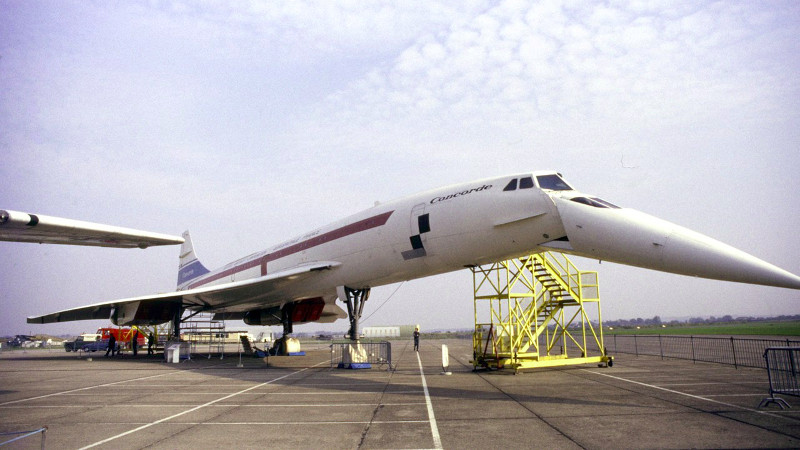The Politics of Supersonic Flight: the Concord(e) - 5 minutes read

Every nation has icons of national pride: a sports star, a space mission, or a piece of architecture. Usually they encapsulate a country’s spirit, so citizens can look up from their dreary lives and say “Now there‘s something I can take pride in!” Concorde, the supersonic airliner beloved by the late 20th century elite for their Atlantic crossings, was a genuine bona-fide British engineering icon.
But this icon is unique as symbols of national pride go, because we share it with the French. For every British Airways Concorde that plied the Atlantic from London, there was another doing the same from Paris, and for every British designed or built Concorde component there was another with a French pedigree. This unexpected international collaboration gave us the world’s most successful supersonic airliner, and given the political manoeuverings that surrounded its gestation, the fact that it made it to the skies at all is something of a minor miracle.
In the 1950s, the direction of post-war aviation had been set by the first generation of four-engined jet passenger aircraft. Planes such as the De Haviland Comet, Tupolev TU-104, Sud Aviation Caravelle, and Boeing Dash-80 prototype are the visible ancestors of today’s airliners, but just as the future of jet fighter aircraft lay in supersonic designs it was envisaged that so too would the future of civil aviation.
By the 1980s, we would zip around the world at twice the speed of sound, and naturally the aircraft manufacturers of the day wanted a slice of that market. Governments and major manufacturers worldwide set their designers researching the feasibility of transforming design elements created for supersonic military aircraft into civilian airliners. By the end of the 1950s the French Sud Aviation and British BAC had advanced to the point of in 1960 investigating a joint venture, and were surprised to find that each other’s designs had arrived at a substantially similar shape and configuration.
A common design was agreed, and the respective governments contemplated a formal treaty. At this time, the British government was being blocked by the French from European Community membership, and was seeking anything that would sweeten their eventual membership. They thus pushed for a deal, and inserted punitive clauses for breaking it in the resulting 1962 treaty. The aircraft would be built as a cooperative effort between the two countries, with both governments funding the development in the expectation that they could get a head start over the Americans in equipping the airlines of the 1970s.
The aircraft that emerged had the familiar thin fuselage and long curved delta wing, and had four Rolls-Royce Olympus 593 turbojet engines derived from those used on the Avro Vulcan bomber mounted under the wings. For use at supersonic speeds, these engines had special intake ducts designed to slow the air down to subsonic speeds. And although they were fitted with afterburners for the climb to cruising altitude, these intakes gave the Concorde the ability to “supercruise”, or cruise at mach 2 supersonic speeds without afterburners engaged.
It is inevitable that such a project, at the edge of what is possible, will incur significant overruns. The Concorde was no exception. The first estimate of £70 million soared to a billion and beyond. That the project survived at all was due only to the expense of pulling out due to that punitive clause.
The sometimes testy relationship between the two countries’ political leadership was reflected in its name, variously being referred to with the French spelling of “Concorde” or the English “Concord”. The version with an “e” was finally adopted.
The two prototype aircraft made their maiden flights in 1969, with the French Concorde in Toulouse being the first. These two planes flew into a different environment from that envisaged in the 1950s. Concerns about noise and pollution, as well as the Oil Crisis in the early 1970s, led to much of the interest of the airlines in supersonic luxury travel melting away, and by the time the first production aircraft were under way only the two national airlines remained. The two governments were left having spent eye-watering sums to produce only a few aircraft, and opted to swallow the loss by passing them to the airlines. They were sold to the public as that source of national pride, and to this day that is how they are seen rather than as a colossal sinkhole of public money.
Concorde’s use for special charter flights meant that it would often fly over parts of the UK outside of its normal scheduled routes, and even when it was a couple of decades old it would cause people to stop and watch it go by. “National icon” is a phrase that is sometimes used inappropriately, but for Brits and presumably the French too, it definitely applied to Concorde during those decades. It seemed to be a fixture without an end to its service.
But in July 2000, the aircraft suffered its first and only fatal crash. An Air France charter flight hit a piece of runway debris at Paris Charles de Gaulle airport, causing a fuel tank failure and fire that led to the aircraft crashing with the loss of all on board after only two minutes of flight.
The fleet was grounded while investigations were carried out and all aircraft were fitted with fuel tank modifications, but their return to the air was short-lived. In 2003 the entire fleet was retired by both airlines, causing a brief controversy. Civilian supersonic airline flight had not become travel for the masses as was once predicted, and while still a source of national pride, the aircraft had become something of an anachronism. Meanwhile we’re left to queue for our twin-engined subsonic widebody aircraft flights, and hope that one day Reaction Engines might rekindle the dream.
Source: Hackaday
Powered by NewsAPI.org